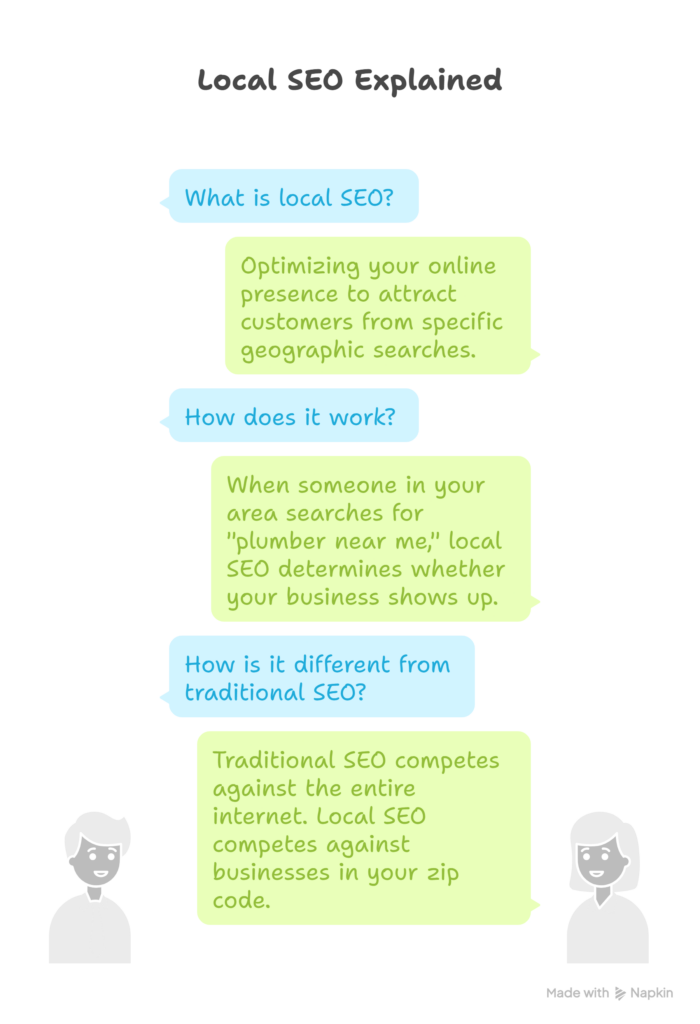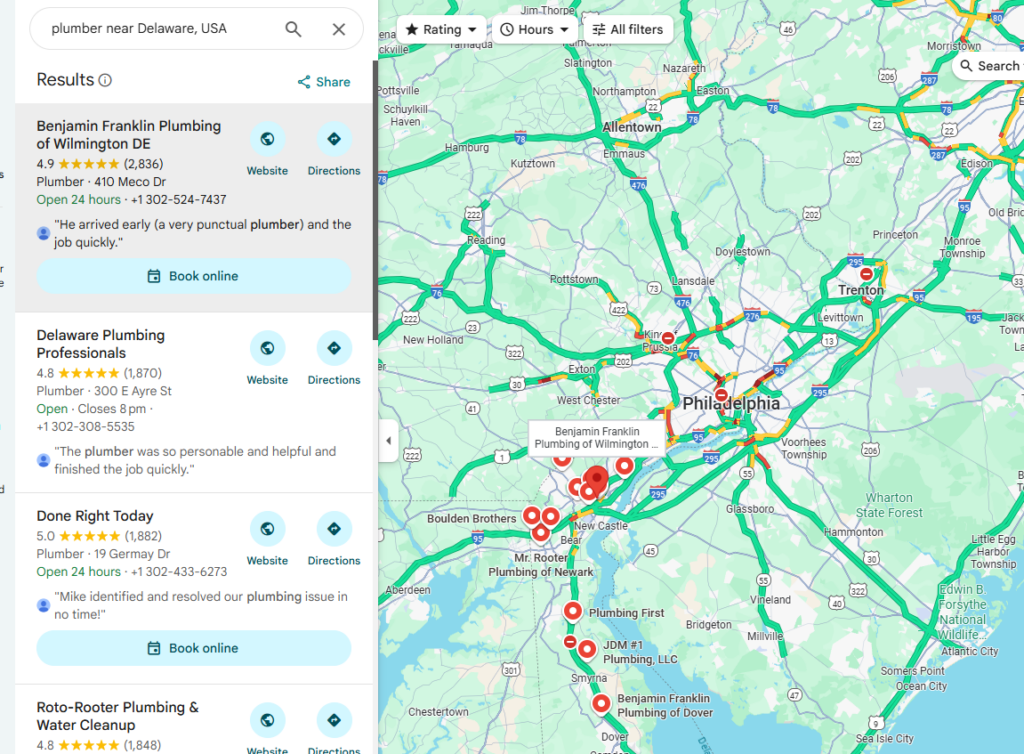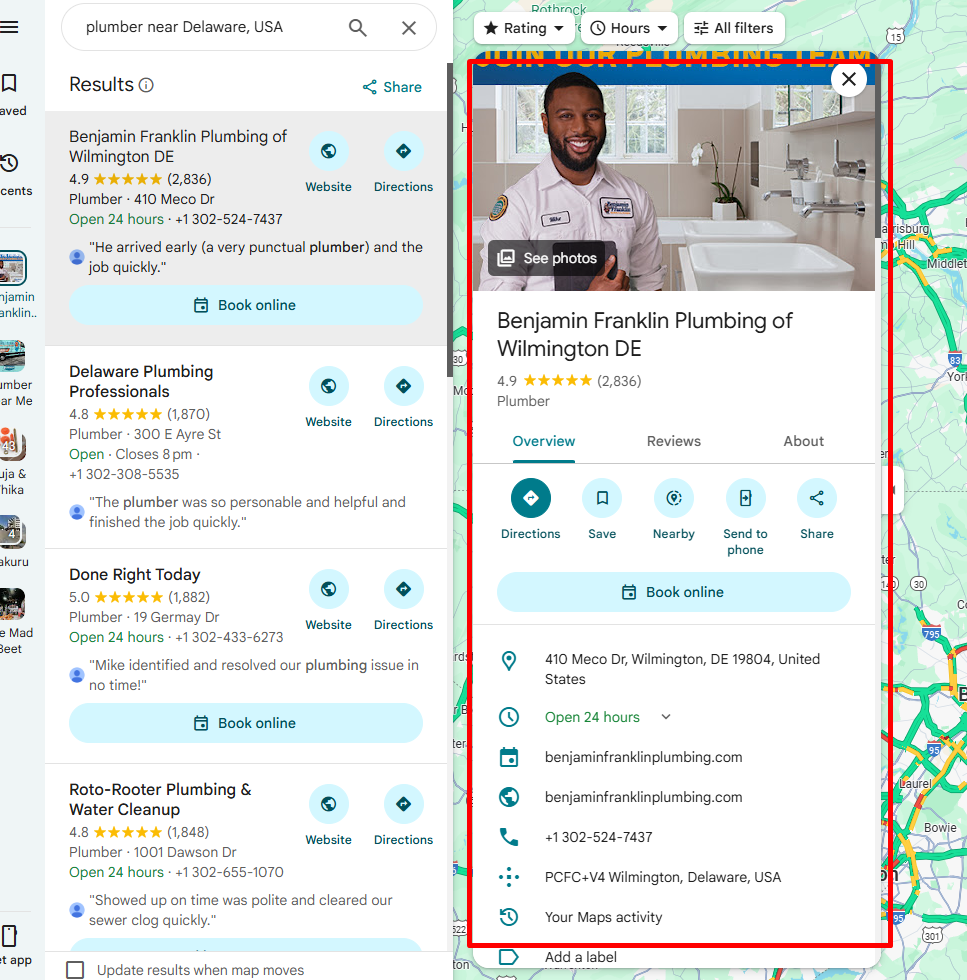“Why aren’t people finding my business online?”
That’s what Marcus, a plumber in Austin, asked himself after watching a competitor with worse reviews consistently show up first in Google searches.
Same city.
Same services.
Different results.
The difference? Local SEO.
Here’s what most business owners don’t realize: 80% of consumers search for local businesses online at least weekly, and 46% of all Google searches have local intent.
That’s not a small segment of potential customers—that’s the majority of your market actively looking for you right now.
And if they can’t find you? They’re finding your competitor instead.
Why This Matters for Your Business
Every day you’re not visible in local search results is a day you’re handing customers to competitors.
78% of mobile local searches lead to an offline purchase, often within 24 hours. These aren’t window shoppers—they’re ready-to-buy customers with credit cards in hand.
But here’s the reality: most local businesses are leaving massive money on the table because they either don’t understand local SEO or think it’s too complicated to tackle.
The truth?
It’s neither mysterious nor optional anymore. It’s table stakes for staying in business.
That’s exactly why we built our local SEO service—to handle the technical heavy lifting while you focus on serving customers. But first, let’s demystify what local SEO actually is and why it’s printing money for the businesses that get it right.
Read also: 10 PROVEN Ways Local SEO Can Help You Grow Your Business
What Exactly Is Local SEO?
Local SEO is the process of optimizing your online presence to attract customers from specific geographic searches.

Strip away the jargon, and it’s simple: when someone in your area searches for “plumber near me” or “best Italian restaurant in [city],” local SEO determines whether your business shows up or disappears into digital obscurity.

Think of it this way: traditional SEO is competing against the entire internet.
Local SEO is competing against businesses in your zip code.
One is nearly impossible for small businesses.
The other is completely winnable.
Read also: Here’s Why Local SEO Is More Important Than Ever
The Local Search Ecosystem: Where Your Customers Find You

Local SEO isn’t just about Google rankings. It’s a multi-channel game:
- Google Business Profile (formerly Google My Business): The single most powerful local SEO asset you own
- Google Maps: Where mobile searches convert into foot traffic
- Local Pack Results: Those three businesses that appear in the map box at the top of search results
- Organic Local Rankings: Traditional search results filtered by location
- Voice Search: “Hey Siri, find a dentist nearby”
- Review Sites: Yelp, TripAdvisor, industry-specific directories
Each channel feeds the others. Neglect one, and you’re fighting with one hand tied behind your back.
How Local SEO Actually Works (The Real Story)
Google’s local search algorithm has three core factors. Master these, and you master local SEO:
1. Relevance: Does Your Business Match What People Search For?
Google needs to understand what you do and who you serve. This means:
- Accurate business categories on your Google Business Profile
- Keyword-optimized content that matches actual search queries
- Clear service descriptions that tell Google (and customers) exactly what you offer
- Location-specific pages if you serve multiple areas
Example: Joan owns a dog grooming salon in Portland. She wasn’t showing up for “dog grooming Portland” because her Google Business Profile listed her category as “Pet Store.”
One category change led to a 340% increase in profile views within three weeks.
2. Proximity: How Close Are You to the Searcher?
You can’t fake geography. Google knows where your business is located and where the searcher is when they search.
But here’s the play: proximity matters most when relevance and prominence are equal. If your business is farther away but significantly more relevant and prominent, you can still outrank closer competitors.
3. Prominence: Are You the Obvious Choice?
This is where most local businesses fall flat. Prominence includes:
- Review quantity and quality (more positive reviews = higher rankings)
- Citation consistency (your business name, address, phone number matching everywhere online)
- Backlinks from local websites and directories
- Social signals and engagement
- On-site SEO factors like page speed and mobile optimization
Verified businesses receive over 21,643 views each year in Google searches. That’s not luck—that’s prominence working in your favor.
Read also: How Local SEO Works: A Simple Explanation for Business Owners
The Google Business Profile (Your Local SEO Foundation)
Let’s cut to it: if you do nothing else, claim and optimize your Google Business Profile.
Here’s why: Customers are 2.7 times more likely to trust a business if they come across a complete Business Profile on search and Google Maps.
What “Complete” Actually Means
- All information fields filled out (hours, phone, website, services)
- 10+ high-quality photos updated monthly
- Primary and secondary categories accurately selected
- Regular posts (weekly minimum)
- Active Q&A section with proactive answers to common questions
- Consistent response to reviews (both positive and negative)
Example: Tony runs a HVAC company in Phoenix. His Google Business Profile was claimed but bare bones—just name and phone number. After a complete optimization (total time invested: 6 hours), his calls from Google increased by 185% in 60 days. Cost? Zero dollars.
Local Search Rankings: The Components That Actually Move the Needle
NAP Consistency (Name, Address, Phone Number)
This sounds stupidly simple, but inconsistency here kills local rankings faster than anything else.
Wrong:
- Website: “Johnson’s Plumbing LLC, 123 Main Street”
- Google: “Johnson Plumbing, 123 Main St.”
- Yelp: “Johnson’s Plumbing, 123 Main Street Suite A”
Right: Identical information everywhere. Period.
Local Citations
These are online mentions of your business name, address, and phone number. Think:
- Yelp
- Yellow Pages
- Industry-specific directories
- Chamber of Commerce listings
- Local news sites
- BBB
The game isn’t just quantity—it’s quality and consistency. 50 accurate citations beat 200 inconsistent ones every time.
Reviews (The Trust Currency)
Over 90% of consumers check online reviews before visiting a business. Reviews aren’t just social proof—they’re a direct ranking factor.
The review strategy that works:
- Ask every satisfied customer for a review (yes, every single one)
- Make it stupid easy (send them a direct link)
- Respond to 100% of reviews within 24 hours
- Never, ever buy fake reviews (Google will nuke your listing)
On-Page Local SEO
Your website needs to scream “local business” to Google:
- Location keywords in title tags: “Best Pizza in Brooklyn | [Your Business Name]”
- Location-specific content: Service area pages, local blog posts, neighborhood guides
- Schema markup: Structured data that tells Google exactly what you are
- Mobile optimization: Mobile-first indexing is essential for local SEO
- Fast load times: Every second of delay costs you customers
Common Local SEO Questions (Answered Honestly)
“How much does local SEO cost?”
The real answer: It depends on whether you do it yourself or hire help.
DIY Route: $0-$200/month (mostly time investment)
- Claiming and optimizing your Google Business Profile: Free
- Basic directory submissions: Free to $50/month for automation tools
- Review management: Free (just ask)
- Content creation: Free (your time)
Professional Route: $500-$5,000/month depending on competition and scope
The question isn’t “can I afford local SEO?” It’s “can I afford to keep losing customers to competitors who are investing in it?” One new customer from local search likely pays for months of SEO work.
Our local SEO service sits in the sweet spot—handling the technical complexity while delivering measurable ROI without enterprise-level pricing.
“How long until I see results?”
The truth: 30-90 days for initial improvements. 6-12 months for dominant market position.
Anyone promising overnight results is lying. But here’s what you CAN expect:
- Week 1-2: Google Business Profile optimization complete, showing up in more searches
- Month 1: Citation building in progress, review count increasing
- Month 2-3: Ranking improvements for low-competition keywords, more calls/visits
- Month 4-6: Competitive keywords moving up, consistent lead flow established
- Month 6-12: Top 3 rankings for primary keywords, predictable customer acquisition
“Do I really need a website for local SEO?”
Short answer: Technically no. Practically yes.
You can rank in local results with just a Google Business Profile. But you’re leaving money on the table. Here’s why:
A website gives you:
- Credibility: Customers trust businesses with professional websites
- Control: You own the content and messaging
- Conversion tools: Contact forms, service details, pricing information
- Tracking: Analytics to understand what’s working
- Content marketing: Blog posts and pages that rank for additional keywords
“What’s the difference between local SEO and regular SEO?”
Local SEO = geographic-specific searches with buying intent (“dentist near me”) Regular SEO = broader informational searches (“how to fix a toothache”)
For local businesses, local SEO drives customers through your door. Regular SEO builds brand awareness. You need both, but local SEO is where immediate revenue lives.
“Can I do local SEO myself?”
Honest answer: Yes, but it’s time-consuming and technical.
Can you learn it? Absolutely. Should you spend 10-15 hours per week doing it instead of running your business? That’s the real question.
Time investment breakdown:
- Google Business Profile optimization: 5-8 hours (one-time)
- Monthly posting and updates: 4-6 hours/month
- Review monitoring and responses: 3-5 hours/month
- Citation building: 8-12 hours (one-time)
- Content creation: 8-12 hours/month
- Technical SEO: 4-8 hours/month
- Link building: 6-10 hours/month
Total: 30-50 hours/month to do it right.
Most business owners get about three weeks in before abandoning it halfway through. Not because it’s impossible—because their time is worth more spent on their actual business.
Read also: How to Start Doing Local SEO from Scratch
Local SEO for Different Business Types
Restaurants & Food Service
Priority actions:
- Google Business Profile with mouth-watering photos
- Menu posted directly on Google (not just a PDF)
- Table reservation integration
- Review generation from satisfied diners
- Location-specific blog content (“Best Date Night Restaurant in [Neighborhood]”)
Example: A Mexican restaurant in San Diego added 50 high-quality food photos to their Google Business Profile and enabled table reservations. Direct bookings from Google increased 217% in the first month.
Home Services (Plumbers, Electricians, HVAC, Contractors)
Priority actions:
- Service area pages for every neighborhood you serve
- Before/after project photos
- Emergency service callouts
- Clear pricing expectations (even ranges help)
- Local licenses and certifications displayed prominently
Critical: Home service businesses live and die by reviews. A systematic review collection process is non-negotiable.
Medical & Dental Practices
Priority actions:
- Multiple location pages if applicable
- Doctor/staff bios with credentials
- Insurance accepted clearly listed
- Patient testimonials (HIPAA-compliant)
- FAQ content addressing common concerns
Special consideration: Medical practices face stricter regulations. Content must be accurate, verifiable, and compliant with healthcare advertising laws.
Retail & Storefront Businesses
Priority actions:
- Product photos and inventory hints on Google
- Store hours (including special holiday hours)
- In-store pickup options
- Local event participation
- Neighborhood partnerships and collaborations.
Read also: Local SEO vs Traditional SEO: What’s the Real Difference?
The Local SEO Mistakes Costing You Customers
1. Inconsistent Business Information
Your business is listed as “Johnson Plumbing” in one place and “Johnson’s Plumbing LLC” in another. Google doesn’t know they’re the same business. You disappear from results.
Fix time: 4-8 hours to audit and correct
2. Ignoring Reviews
Over 90% of consumers check online reviews before visiting a business. Ignoring them (especially negative ones) is business suicide.
Fix time: 30 minutes daily
3. No Google Business Profile Posts
Regular posts signal to Google that your business is active and engaged. They also give you more real estate in search results.
Fix time: 20 minutes weekly
4. Keyword Stuffing
“Best Chicago pizza restaurant pizza deep dish pizza Chicago best pizza” doesn’t work. It never did. Write for humans, not robots.
Fix time: Content rewrite (varies)
5. No Mobile Optimization
78% of mobile local searches lead to an offline purchase. If your website looks terrible on phones, you’re losing those sales.
Fix time: 20-40 hours (hire a developer)
Your 30-Day Local SEO Action Plan
Week 1: Foundation
- Claim your Google Business Profile
- Verify your listing
- Add complete business information
- Upload 10+ high-quality photos
- Select accurate categories
Week 2: Visibility
- Submit to top 10 local directories
- Audit NAP consistency across existing listings
- Set up Google Business Profile posts (schedule 4)
- Create or update 3 key website pages
Week 3: Reviews
- Implement review request system
- Respond to all existing reviews
- Add review widgets to website
- Create review generation strategy
Week 4: Content & Refinement
- Publish 1 local-focused blog post
- Update Google Business Profile Q&A
- Create service area pages
- Set up local schema markup
This is aggressive. If you’re running a business solo, expect this to take 8-12 weeks. That’s why many smart business owners outsource it.
When to Hire Professional Help
You should consider professional local SEO services when:
- You don’t have 10+ hours per week to dedicate to SEO
- Your competitors are dominating local search results
- You’ve tried DIY and aren’t seeing results
- Your time is better spent on high-value business activities
- You’re expanding to multiple locations
- You need guaranteed results with accountability
A professional service (like our local SEO offering) handles the technical complexity, stays updated on algorithm changes, and delivers measurable results while you focus on what you do best—running your business.
What to look for in a local SEO service:
- Transparent reporting (you should see exactly what’s being done)
- No long-term contracts (month-to-month proves confidence)
- Clear deliverables and timelines
- Case studies from similar businesses
- Direct communication (not just automated reports).
In the meantime, use our free tool to get an in-depth report of how your GBP is doing.
The Bottom Line: Local SEO Is a Competitive Advantage, Not a Marketing Expense
Here’s what separates winning local businesses from struggling ones: they understand that local SEO isn’t a cost—it’s an acquisition channel with measurable ROI.
Every dollar invested in local SEO returns customers who are:
- High-intent: Actively searching for your services right now
- Local: Within your service area, ready to buy
- Qualified: Already sold on the need, just choosing a provider
Compare that to traditional advertising where you’re interrupting people who weren’t looking for you in the first place.
80% of local searches result in users converting into customers. That’s not a marketing channel—that’s a revenue machine.
The question isn’t whether you can afford to invest in local SEO. It’s whether you can afford to keep losing customers to competitors who already are.
Ready to Stop Losing Customers to Competitors?
You’ve got two paths forward:
Path 1: Spend the next 6-12 months learning local SEO, implementing it yourself, and hoping you don’t make costly mistakes along the way.
Path 2: Let professionals who do this daily handle the technical work while you focus on serving customers and growing your business.
If you’re ready for Path 2, our local SEO service is built specifically for local businesses that want results without the technical headache. We handle everything from Google Business Profile optimization to citation building to review management—with transparent reporting so you see exactly what’s working.
Want to see what local SEO could do for your business specifically? Let’s talk about your market, your competition, and what a dominant local presence would mean for your revenue.
Because here’s the truth: Your competitors aren’t waiting. Every day you delay is another day they’re capturing customers who should be yours.
The local SEO game is winnable. You just need to decide if you’re playing to win or playing not to lose.
Read also: